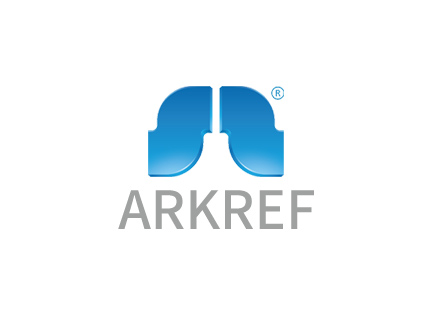Understanding Slaughter Cold Rooms for Meat Storage
A slaughter cold room plays a vital role in preserving the quality and safety of meat. It provides a controlled environment where precise temperature and humidity control prevent spoilage and extend shelf life. By maintaining optimal conditions, meat cold rooms ensure that meat stays fresh, flavorful, and safe for consumption. Proper temperature management slows bacterial growth, while regulated humidity prevents weight loss and surface drying. This combination not only protects the meat but also enhances its overall value for businesses and consumers alike.
Key Takeaways
Slaughter cold rooms are essential for preserving meat quality by maintaining optimal temperature and humidity levels, which prevent spoilage and extend shelf life.
Proper temperature management is crucial; frozen meat should be stored at -20°C (-4°F) or lower, while fresh meat requires temperatures between 0°C (32°F) and 4°C (39°F).
Efficient air circulation and ventilation systems are vital for even cooling and moisture control, reducing the risk of bacterial growth and ice formation.
Hygienic design and easy-to-clean surfaces in cold rooms help maintain a sterile environment, minimizing contamination risks and ensuring compliance with health standards.
Implementing best practices, such as safe handling and regular cleaning, is key to preventing contamination and ensuring the quality and safety of meat products.
Energy-efficient technologies can significantly reduce operational costs while maintaining optimal performance, making them a smart investment for meat storage facilities.
Regular maintenance and troubleshooting are essential to keep cold rooms functioning effectively, ensuring that meat remains fresh, safe, and market-ready.
How Slaughter Cold Rooms Work
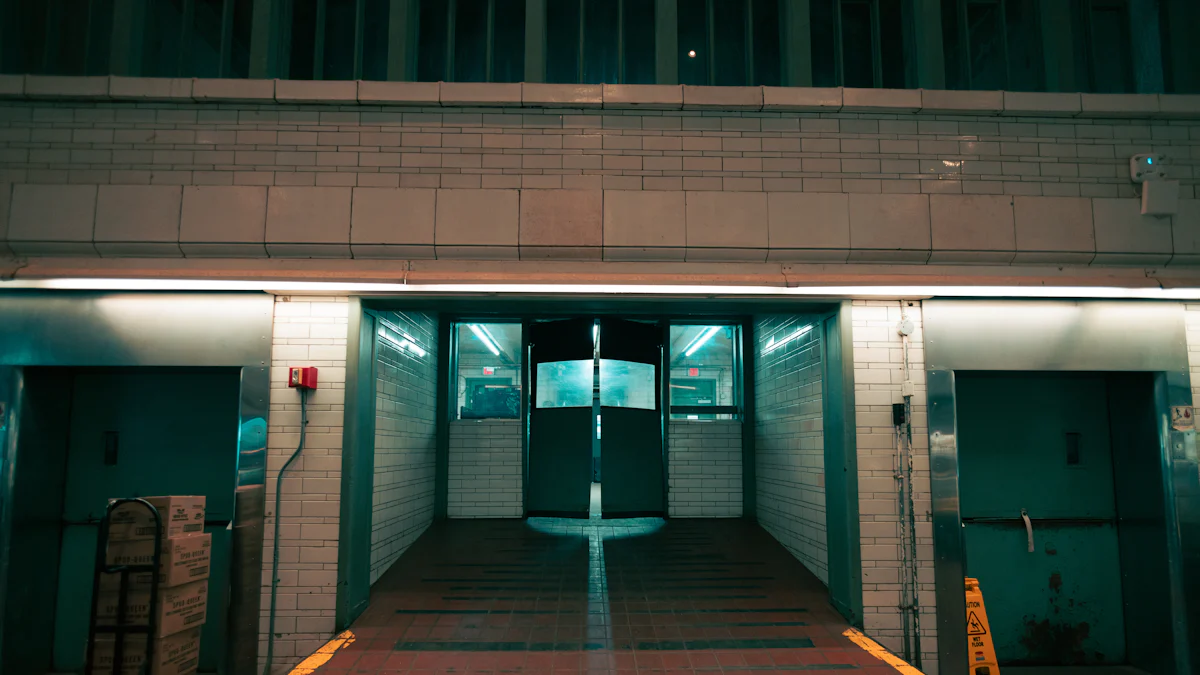
Slaughter cold rooms are designed to create an environment that preserves the freshness and safety of meat. These rooms rely on advanced systems to regulate temperature, airflow, and humidity, ensuring optimal storage conditions. Understanding how these components work together helps you maximize the efficiency of your cold room.
Temperature Ranges for Meat Storage
Maintaining the right temperature is critical for preserving meat quality. Most meat cold rooms operate within specific temperature ranges depending on the type of meat being stored. For frozen meat, temperatures typically stay at or below -20°C (-4°F). Fresh meat requires slightly higher temperatures, usually between 0°C (32°F) and 4°C (39°F). These controlled settings slow bacterial growth and prevent spoilage.
Research highlights the importance of precise temperature control in extending the shelf life of meat. Refrigerated environments inhibit microbial activity, keeping meat safe for longer periods. By adhering to these temperature guidelines, you ensure that your products remain fresh and meet health standards.
Air Circulation and Ventilation Systems
Proper air circulation plays a vital role in maintaining consistent cooling throughout the cold room. Advanced ventilation systems distribute cold air evenly, preventing hot spots and ensuring that all stored meat receives uniform cooling. This process also helps remove excess heat generated by the refrigeration units.
Efficient air circulation reduces the risk of moisture buildup, which can lead to ice formation and uneven cooling. Systems like ceiling-mounted air coolers, commonly used in slaughter cold rooms, enhance airflow and maintain stable conditions. Proper air circulation not only preserves meat quality but also optimizes the performance of your refrigeration system.
Humidity Control and Its Role in Meat Preservation
Humidity control is another essential factor in meat preservation. High humidity levels can cause condensation, leading to bacterial growth and surface spoilage. On the other hand, low humidity can dry out the meat, resulting in weight loss and reduced quality. Striking the right balance is key.
Modern cold rooms use advanced technology to regulate humidity levels. These systems maintain an environment that prevents surface drying while avoiding excessive moisture. By controlling humidity, you protect the texture, flavor, and appearance of your meat, ensuring it remains appealing to consumers.
"Research in meat preservation emphasizes the importance of combining temperature and humidity control to extend shelf life and maintain quality."
By understanding how slaughter cold rooms work, you can create the ideal conditions for storing meat. Temperature, airflow, and humidity must work together to ensure your products stay fresh, safe, and market-ready.
Key Features of a Slaughter Cold Room
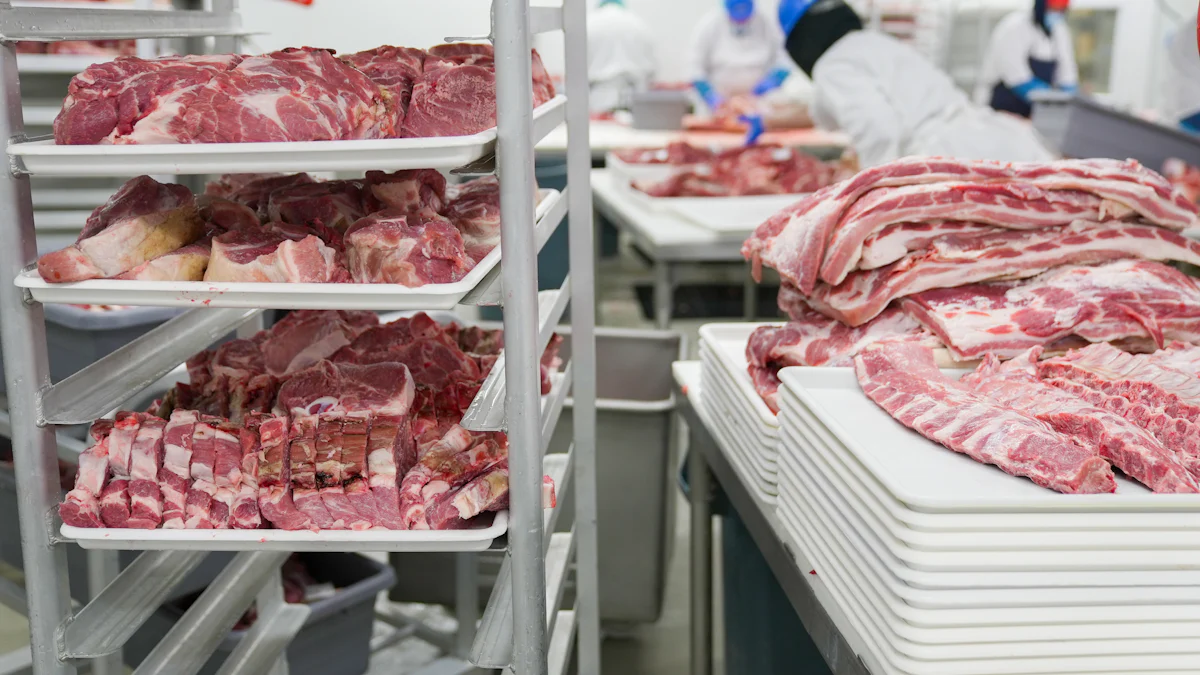
Pre-Cooling and Blast Freezing Capabilities
Pre-cooling and blast freezing are essential features of a slaughter cold room. Pre-cooling rapidly reduces the temperature of freshly slaughtered meat to inhibit bacterial growth. This process ensures that the meat enters storage at an optimal temperature, preserving its freshness and quality. Blast freezing, on the other hand, freezes meat quickly at extremely low temperatures, typically below -20°C. This method locks in the meat's natural moisture and flavor while preventing the formation of large ice crystals that can damage its texture.
These capabilities are particularly valuable for businesses handling large quantities of meat. By incorporating pre-cooling and blast freezing, you can extend the shelf life of your products and maintain their market value. Advanced cold room refrigeration systems, such as air-cooled condensing units, enhance the efficiency of these processes, ensuring consistent performance.
Hygienic Design and Easy-to-Clean Surfaces
Hygiene is a top priority in meat cold rooms. A well-designed cold room features smooth, non-porous surfaces that resist bacteria and are easy to clean. Materials like stainless steel or food-grade plastic are commonly used for walls, floors, and ceilings. These surfaces prevent contamination and ensure compliance with health and safety standards.
Regular cleaning and sanitization are crucial for maintaining a sterile environment. A hygienic design minimizes the risk of residue buildup, making it easier for you to clean the cold room thoroughly. This not only protects the quality of your meat but also reduces the likelihood of spoilage and waste.
Proper Airflow and Even Cooling Distribution
Effective airflow is critical for maintaining consistent cooling throughout the cold room. Ceiling-mounted air coolers and advanced ventilation systems distribute cold air evenly, ensuring that all areas of the room remain at the desired temperature. Proper airflow prevents hot spots and eliminates the risk of uneven cooling, which could compromise the quality of stored meat.
In addition to temperature consistency, efficient airflow reduces moisture buildup. This prevents ice formation and ensures that the meat cold storage environment remains stable. Thoughtful storage solutions, such as modular stacking systems, can help optimize space without obstructing airflow. By prioritizing proper airflow, you can maximize the efficiency of your cold room and protect your products.
"Cold room user guides often emphasize the importance of even cooling distribution to maintain product integrity and reduce energy consumption."
These key features make a slaughter cold room an indispensable tool for meat storage. Pre-cooling and blast freezing preserve freshness, hygienic designs ensure safety, and proper airflow guarantees consistent performance. Together, these elements create an environment that supports the longevity and quality of your meat products.
Best Practices for Using a Meat Cold Room
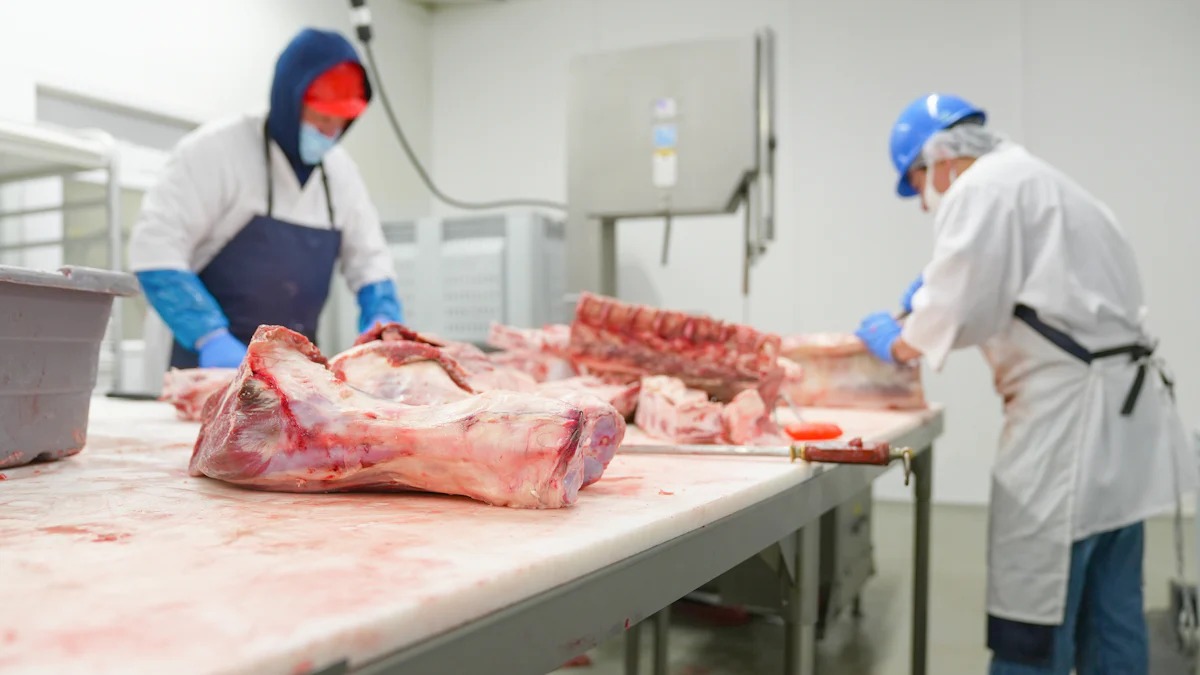
Recommended Temperature Settings for Different Meat Types
Maintaining the correct temperature is essential for safe meat storage. Different types of meat require specific temperature ranges to preserve their freshness and prevent spoilage. For frozen meat storage, set your cold room to -20°C (-4°F) or lower. This temperature halts bacterial growth and keeps the meat safe for extended periods. For chilled meat storage, maintain a range between 0°C (32°F) and 4°C (39°F). This range slows microbial activity while preserving the meat's texture and flavor.
Adhering to these temperature settings ensures proper safety and quality control. Studies show that refrigerated environments significantly extend the shelf life of meat by inhibiting microbial growth. By following these guidelines, you can reduce spoilage and maintain the integrity of your products.
Storage Durations and Shelf Life Guidelines
Understanding how long meat can be stored in a cold room is crucial for maintaining quality. Fresh meat stored at chilled temperatures typically lasts up to nine days before spoilage begins. This timeline varies depending on the type of meat and its initial freshness. For frozen meat, storage durations can extend to several months, provided the temperature remains consistently low.
To maximize shelf life, always label and date your products. Rotate stock using the "first in, first out" method to ensure older items are used before newer ones. Research indicates that proper organization and adherence to refrigeration temperature and time guidelines help reduce waste and maintain product quality. By following these practices, you can optimize your cold room for meat storage.
Safe Handling Practices to Prevent Contamination
Preventing contamination is a critical aspect of using a meat cold room. Always handle meat with clean gloves and tools to avoid introducing harmful bacteria. Store different types of meat separately to prevent cross-contamination. For example, keep poultry, beef, and pork in distinct sections of the cold room. A survey of supermarket butcheries found that 83% physically separated meats in display fridges, highlighting the importance of this practice.
Regularly clean and sanitize all surfaces, including shelves and walls, to maintain a hygienic environment. Ensure proper airflow within the cold room to prevent moisture buildup, which can lead to bacterial growth. By implementing these safe storage procedures, you protect your products and ensure compliance with health standards.
"Safe handling and storage practices are essential for maintaining the quality and safety of meat products."
By following these best practices, you can create an efficient and reliable system for how to safely store meat. Proper temperature settings, adherence to shelf life guidelines, and contamination prevention measures ensure your cold room operates at its best. These steps not only protect your products but also enhance customer satisfaction and trust.
Maintenance and Troubleshooting for Meat Cold Rooms
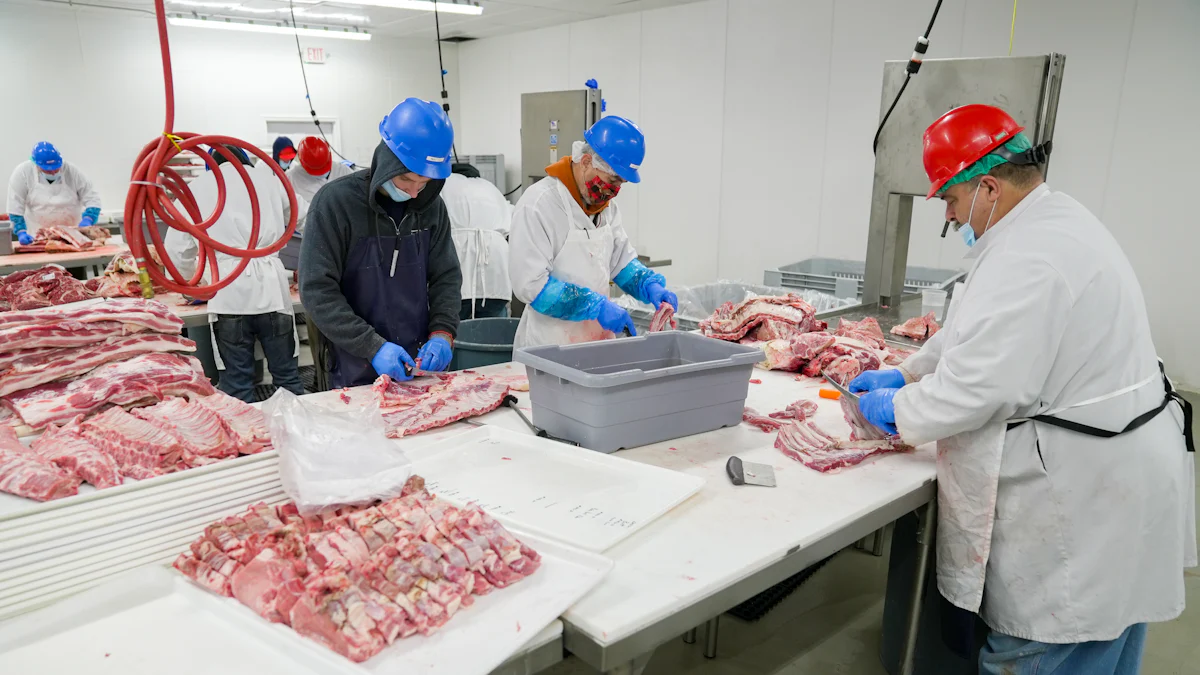
Proper maintenance of your cold room ensures it operates efficiently and preserves the quality of stored meat. Regular upkeep prevents spoilage and contamination, keeping your products safe and fresh.
Routine Cleaning and Sanitization
Routine cleaning is essential for maintaining a hygienic environment in your cold room. You should keep floors and surfaces clean and clear at all times. Use a vacuum cleaner to remove dust from the floor. Tackle surfaces with a cloth, warm water, and mild detergent or specialized cold room cleaning products. Clean any spillages immediately and discard spoiled products to prevent bacteria growth. Regularly check and organize your stock, removing expired goods to avoid spoilage and product loss.
Defrosting Processes and Ice Buildup Prevention
Ice buildup can compromise the efficiency of your cold room. Regularly check walls, ceilings, and floors for ice accumulation and remove it promptly. This is especially important if you store vegetables and fruits, as ice can spoil them. Defrosting processes should be part of your routine maintenance to ensure optimal performance. Use appropriate cold room cleaning products to prevent the growth of microorganisms like bacteria or mold, which can contaminate stored items.
Common Issues and How to Address Them
Common issues in a meat cold room include temperature fluctuations, ice buildup, and equipment malfunctions. To address temperature fluctuations, regularly check if the refrigeration system is working effectively. Ensure proper airflow to maintain consistent cooling. For ice buildup, follow regular defrosting procedures and maintain a clean environment. If equipment malfunctions occur, consult a professional technician to diagnose and fix the problem promptly. By addressing these issues, you ensure your cold room for meat operates efficiently and safely.
"Regular maintenance and troubleshooting are crucial for the efficient operation of a slaughter cold room."
By following these maintenance and troubleshooting tips, you can optimize your meat cold storage environment. This ensures your products remain fresh, safe, and market-ready, enhancing customer satisfaction and trust.
Cost-Effective Storage Solutions for Meat Cold Rooms
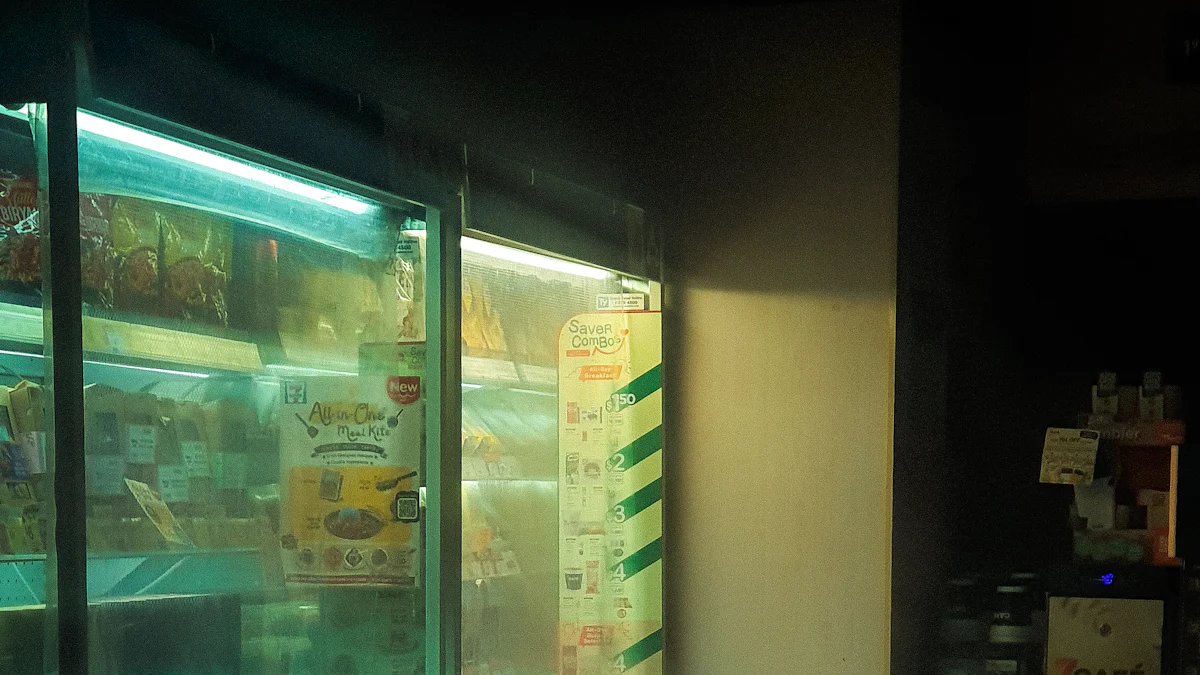
Benefits of Mobile Cold Rooms for Small-Scale Operations
Mobile cold rooms offer a practical solution for small-scale operations. These portable units provide flexibility, allowing you to store and transport meat efficiently. They are ideal for businesses with limited space or those requiring temporary storage during peak seasons. Mobile cold rooms ensure that your products remain fresh and safe, even in remote locations.
The cost of mobile cold rooms is often lower than building a permanent facility. This makes them an excellent choice for startups or small businesses. You can also customize these units to meet specific storage needs, such as adding shelving or adjusting temperature settings. By choosing the right meat cold room solution, you can optimize your operations without overspending.
"Mobile cold rooms combine convenience and affordability, making them a valuable asset for small-scale meat storage."
Energy-Efficient Technologies to Reduce Costs
Energy-efficient technologies play a crucial role in reducing operational costs. Modern cold rooms use advanced refrigeration systems that consume less energy while maintaining optimal performance. For example, combining the thermodynamic properties of R290 refrigerant with variable speed compressors significantly improves energy savings. These innovations ensure that your cold room operates efficiently without compromising on quality.
Upgrading to energy-efficient equipment may require an initial investment, but the long-term savings outweigh the costs. Lower energy consumption reduces utility bills and minimizes your environmental impact. By adopting these technologies, you contribute to sustainability while ensuring safe and effective meat cold storage.
"Energy-efficient refrigeration systems not only cut costs but also support eco-friendly practices in the meat industry."
Tips for Optimizing Energy Usage in Cold Rooms
Optimizing energy usage in your cold room helps you save money and maintain consistent performance. Follow these tips to maximize efficiency:
Regular Maintenance: Clean and inspect your refrigeration system frequently to ensure it runs smoothly. Address any issues promptly to avoid energy waste.
Proper Insulation: Ensure that your cold room is well-insulated to prevent temperature fluctuations. High-quality insulation reduces the workload on your refrigeration system.
Organized Storage: Arrange meat products systematically to allow proper airflow. Avoid overloading the cold room, as this can strain the cooling system.
Monitor Temperature Settings: Use recommended temperature ranges for different meat types. Avoid setting temperatures lower than necessary, as this increases energy consumption.
Upgrade to Energy-Efficient Equipment: Invest in modern technologies, such as variable speed compressors, to enhance energy efficiency.
By implementing these strategies, you can reduce energy costs while maintaining the safety and security measures required for meat storage. These practices ensure that your cold room operates effectively, protecting your products and your bottom line.
"Simple adjustments in energy usage can lead to significant cost savings and improved cold room performance."
Slaughter cold rooms are indispensable for preserving meat quality and ensuring safety. By maintaining precise temperature and humidity levels, they minimize spoilage and reduce the risk of food borne illness. Proper management and regular maintenance extend the shelf life of meat, keeping it fresh and market-ready. Adhering to best practices, such as safe handling and routine cleaning, safeguards your products from contamination. These measures not only protect your inventory but also enhance customer trust and satisfaction. A well-maintained cold room is a cornerstone of success in the meat industry.
FAQ
What types of cold rooms are used in slaughterhouses?
Slaughterhouses typically use cold rooms designed for the cold processing of meat carcasses, including pigs, cattle, and sheep. These cold rooms maintain low temperatures to preserve the freshness and quality of the meat. Some facilities also include specialized areas like pre-cooling chambers and blast freezers to rapidly reduce the temperature of freshly slaughtered meat.
How do cold rooms maintain meat quality?
Cold rooms maintain meat quality by controlling temperature, humidity, and airflow. Low temperatures slow bacterial growth, while proper humidity levels prevent surface drying or excessive moisture. Advanced ventilation systems ensure even cooling, which protects the texture, flavor, and safety of the meat.
What is the difference between pre-cooling and blast freezing?
Pre-cooling lowers the temperature of freshly slaughtered meat quickly to inhibit bacterial growth. This process ensures the meat enters storage at an optimal temperature. Blast freezing, on the other hand, freezes meat rapidly at extremely low temperatures, usually below -20°C. This method locks in moisture and flavor while preventing ice crystal formation that could damage the meat's texture.
Can cold rooms be used for purposes other than meat storage?
Yes, cold rooms serve various purposes beyond meat storage. In hospitals, they store perishable goods like pharmaceuticals and biological materials. Laboratories use them to preserve samples and reagents requiring precise temperature control. Cold rooms also help organizations comply with health regulations by maintaining stable environments for sensitive items.
"Cold rooms are essential for preserving temperature-sensitive products across industries, ensuring safety and compliance."
How do I prevent contamination in a meat cold room?
To prevent contamination, always handle meat with clean gloves and tools. Store different types of meat separately to avoid cross-contamination. Regularly clean and sanitize all surfaces, including shelves and walls. Ensure proper airflow to reduce moisture buildup, which can lead to bacterial growth.
What are the benefits of mobile cold rooms?
Mobile cold rooms provide flexibility and convenience, especially for small-scale operations. They allow you to store and transport meat efficiently, even in remote locations. These units are cost-effective and customizable, making them ideal for businesses with limited space or temporary storage needs.
How often should I clean my cold room?
You should clean your cold room regularly to maintain hygiene and prevent contamination. Clean floors, walls, and shelves weekly using warm water and mild detergent. Remove any spoiled products immediately and sanitize surfaces to eliminate bacteria. Routine cleaning ensures a safe environment for meat storage.
What should I do if ice builds up in my cold room?
Ice buildup can reduce the efficiency of your cold room. Check for ice accumulation on walls, ceilings, and floors regularly. Remove ice promptly and follow defrosting procedures as part of your maintenance routine. Keeping the cold room clean and ensuring proper airflow can help prevent ice formation.
Are energy-efficient cold rooms worth the investment?
Energy-efficient cold rooms reduce operational costs by consuming less energy while maintaining optimal performance. Modern refrigeration systems, such as those using variable speed compressors, improve energy savings. Although the initial investment may be higher, the long-term savings and environmental benefits make them a worthwhile choice.
How do I choose the right cold room for my business?
To choose the right cold room, consider your storage needs, available space, and budget. Evaluate whether you need features like pre-cooling, blast freezing, or mobile units. Energy-efficient technologies and customizable options can also enhance your operations. Consulting with a professional can help you make the best decision for your business.
See Also
Creating a High-Performance Cold Room for Slaughtering
Exploring the Purpose of Cold Storage Facilities
The Role of Cold Rooms in Food Safety
